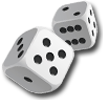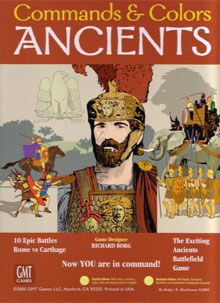



play board games
Board game reviews, strategy tips & session reports
Commands and Colors Ancients Review
 Stats:
Stats:
No. of players: 2
Amount of time to play: 60 min
Age requirements: 12+
Set-up time: 10-20 min
Commands and Colors Ancients Rules Description:
Commands and Colors Ancients is a war game with scenarios from the struggle between Rome and Carthage. You need solid tactics and a bit of luck to win this game.
Each scenario specifies your starting units, their starting placement and the scenario’s victory conditions. The setup also tells you where to place terrain on the hex-based board. Terrain can effect movement, line of sight and the number of dice attackers and defenders roll.
Units are made up of one to four wooden blocks, depending on their type. Units have a color associated with them (green for light units, blue for medium units and red for heavy units). Your units also have different stats. Heavier units roll more attack dice but move slower. Lighter units are able to move farther but attack with less dice. Some of your units may attack from range which is measured in hexes.
Leader units may join with other units and help units in their hex and adjacent hexes hit in close combat. They also boost surrounding units’ morale and may give them bonus attacks when they eliminate their foe.
Command cards specify the units you may act with each round. The board is divided into three sections and a Command card may let you move a certain number of units on one or more sections. Some Command cards allow you to move just one color or type of unit as well. The scenario tells you how many Command cards each player starts the game with. You draw a new one after each turn.
After you choose a Command card you need to say which units you are ordering. You can give actions to your ordered units in any order, but must fully complete an action with one unit before activating a new one.
Combat is dice based and simple. To hit a unit you are attacking, you must roll its color. Some weapons allow you to hit with the crossed swords result and leaders allow you to hit when you roll the leader symbol. After all hits are totaled you remove one block from a unit for each hit inflicted. If you eliminate an entire unit you get a victory banner. Units that are not eliminated may battle back eliminating blocks from the original attacking unit.
Once you claim as many victory banners as the scenario requires you win.
Quick Review of Commands and Colors Ancients:
C&C Ancients has lots of tactical strategy and is fun. You must play to your strengths of your army and to your hand of Command cards. Since there are dice involved you’ll also have to get lucky too.
The Commands and Colors system is used in other games and is easy to learn and teach. This game has a lot of information to either know or keep track of. The player aids help a ton and the rules are well-organized and easy to understand. The components are decent quality and the art fits the theme well.
C&C Ancients includes 15 scenarios. There is a lot to play in this box. There are expansions you can get, but you won’t need them for a bit.
You may be frustrated if the dice don’t go your way, but more frustrating is when the cards don’t play nice. You may really want to give orders to units in the right board section, but only have cards for the left and center sections.
Also be aware there is some assembly required. You will need to add stickers to the wooden blocks. It is not a big deal, but I figured it is best if you knew that ahead of time.
Even though luck is involved here, C&C Ancients is usually won by the player with the better tactics. If you have thought of trying out the Command and Colors system or are looking for a fun war game, C&C Ancients should be on your try or buy list. If you already enjoy the battle system this game will make a great addition to your collection.
Score and synopsis: (Click here for an explanation of these review categories.)
Strategy 4 out of 6
Luck 4 out of 6
Player Interaction 6 out of 6
Replay Value 5 out of 6
Complexity 4 out of 6
Fun 5 out of 6
Overall 5 out of 6

Leave a Reply